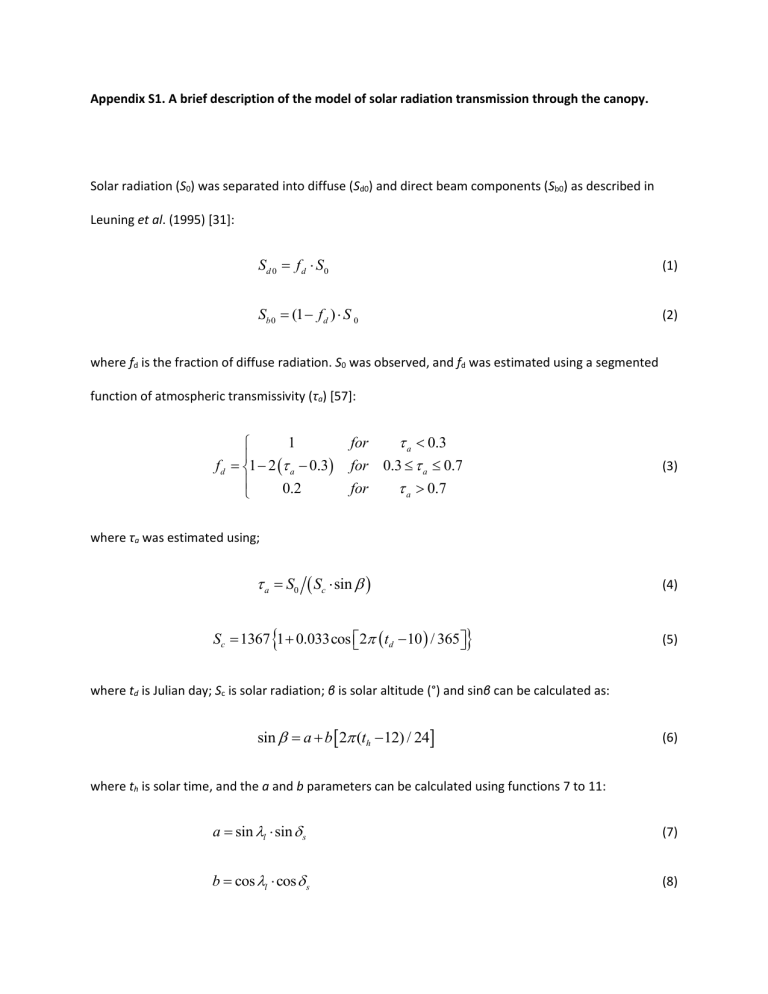Appendix S1. A brief description of the model of solar radiation

Appendix S1. A brief description of the model of solar radiation transmission through the canopy.
Solar radiation (S
0
) was separated into diffuse (S d0
) and direct beam components (S b0
) as described in
Leuning et al. (1995) [31]:
S d 0
f d
S
0
(1)
S b 0
f d
)
S
0
(2) where f d
is the fraction of diffuse radiation. S
0
was observed, and f d
was estimated using a segmented function of atmospheric transmissivity (τ a
) [57]: f d
1 2
1 a
0.2
0.3
for for for
0.3
a
0.3
a
0.7
a
0.7
(3) where τ a
was estimated using;
a
S
0
S c
sin
S c
t d
(4)
(5) where t d
is Julian day; S c
is solar radiation; β is solar altitude (°) and sinβ can be calculated as: sin
a b
t h
12) / 24
where t h
is solar time, and the a and b parameters can be calculated using functions 7 to 11: a
sin
l
sin
s b
cos
l
cos
s
(6)
(7)
(8)
sin
s
t d
10) / 365
(9) where λ l
is latitude and δ s
is solar declination.
The Q varied with canopy location; therefore, the Q of each canopy layer was calculated separately.
Q d 0
f d
Q
0
Q b 0
1 f d
Q
0
(10)
(11) where Q d0
and Q b0
represent the diffusion and direct radiation components of the observed Q
0
, respectively, and 1 W∙m -2 (S
0
) =2 μmol∙m -2 s -1 (Q
0
) [31]. Shaded leaves receive diffuse radiation only, and sunlit leaves receive diffuse and direct beam radiation. The Q absorbed by shaded (Q sh
) and sunlit leaves
(Q sl
) was calculated as:
Q sh
Q ld
Q lbs
(12)
Q sl
Q lb
Q sh
(13)
In equation (12), ξ is cumulative leaf area index from the top canopy; Q ld
′ and Q lbs
represent the incident diffuse and scattered beam radiation, respectively, which are related to the extinction coefficient for radiation and the leaf area index (LAI) [58-59]. In equation (13), Q lb
represents absorbed beam radiation
[31]. Q ld
′ and Q lbs
were calculated as:
Q ld
Q d 0
k d
' (1
cd
k d
(14)
Q lbs
Q b 0
k b
' (1
cb
) exp( k b
k b
(1
l
) exp( k b
)
(15) where ρ cb
is the canopy reflection coefficient for direct radiation, which can be calculated with the canopy reflection coefficient for horizontal leaves (ρ h
) using equation (16) [58]. ρ cd
is the canopy
reflection coefficient for diffusion radiation, with values of 0.057 and 0.389 for visible and near-infrared light, respectively, when diffusion radiation is uniformly distributed in a canopy with spherical leaf angle distribution [31, 59]. k d
′ and k b
′ represent the canopy extinction coefficient of diffusion and direct beam radiation, respectively, calculated using k b
and k d
in equations (17)-(18):
cb
1 exp
2
h
k b
1
k b
(16) k d
'
k d
1
l
1/ 2 k b
'
k b
1
l
1/ 2
(17)
(18)
In equation (16), ρ h
can be calculated as:
h
1
1
l
1/ 2
1
1
l
1/ 2
(19)
In equations (17)-(18), k b
and k d
represent the extinction coefficients of direct beam and diffusion radiation, respectively, in an ideal canopy where a leaf is viewed as a “black body”. σ l
is the scattering coefficient (σ l
= 0.2 for visible light; σ l
= 0.8 for near-infrared radiation). Goudriaan and Van Laar (1994) reported that k d
is approximately 0.8 for spherical leaf angle distributions [59]. k b
is a function of β as follows: k b
0.5 sin
(20)








